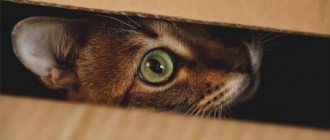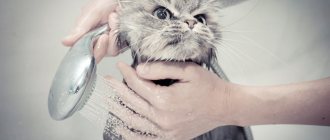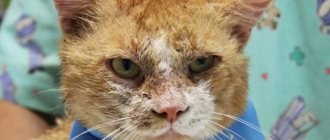4970Pavel
Everyone knows that cats are very capricious. We all love to pet them, but few people know how to properly pet a cat so that you and your pet can enjoy it. There is even a certain technique for this. By following it, you will understand how to properly stroke so that the cat does not show aggression and dissatisfaction.
There are many animals on earth, and there are none who do not love affection, because this feeling is inherent in everyone from birth, when mother washes or strokes. Animals from the cat family love affection like no other species. For cats, stroking is a manifestation of attention, care, and affection towards them.
© shutterstock
Why pet a cat?
Benefit to people
The presence of a four-legged furry in the house itself brings comfort and warmth. When a person returns home, he wants to leave the fuss, troubles, and irritating factors behind the threshold. After petting the cat, he feels a surge of positive emotions, relaxes, calms down, smoothly moving into the comfort zone. Accordingly, this has a positive effect on health - an accelerated pulse returns to normal, relaxation of muscles and vessel walls reduces high blood pressure, and stress goes away. As a result, sleep normalizes. The cat intuitively senses the owner’s mood and “understands” his state.
If a cat lay near a person’s sore spot and purred, the illness may go away.
What benefits does stroking give to four-legged animals?
For cats, such actions are an important part of the relationship. Despite their independent and proud disposition, they love affection, tenderness and attention. When a cat is caressed, the movements remind her of the sensation of being licked by her mother's tongue. From such manipulations, the animal seems to enter a state of light trance, remembering its childhood. In addition, the animal perceives stroking as a massage.
Pleasure and benefit
There has never been a single creature on the planet that does not love affection. Just like humans, animals need care and attention. Cats, like no other animal, love to be petted. Gentle stroking not only brings pleasure to the cat, but also has a beneficial effect on the health of its owner.
Important! The moment you caress your kitten, your blood pressure stabilizes, your nervous system calms down, and your stress level decreases.
But you should definitely take into account the desire and mood of your cat, because the animal does not always want to be stroked. Cats, like people, have different morals and characters. While some people love to be petted and are ready to sit in their arms for hours on end, others only need five minutes to get their fill of affection, after which they begin to pull out, scratch, and sometimes bite.
Important!
In order not to create discomfort for the animal, it is correct to stroke the cat when he wants it, and stop such actions when the animal openly demonstrates reluctance to your caresses.
How do cats show affection to their owner?
We have devoted many publications to the topic of cat love.
And yet we will have to repeat something, refresh our knowledge. "He butts his head." Has your pet “bumped” its head on you? This is not just another cat quirk, but a form of expression of affection.
"Kneads the dough." The cat makes itself more comfortable on the owner and begins to “knead” with its paws, purring loudly. This is nothing but love.
"Brings gifts." A dead mouse in bed is, of course, not a very pleasant surprise. But it's better to come to terms with it. On the contrary, there is a reason to be proud of your pet, because he shares with the owner the most precious thing, his rightful prey.
"He wraps his tail around him." Have you felt like a cat's tail is literally wrapped around you? Wonderful: it means you’re part of your furry friend’s inner circle.
"Cat Kiss" Have you caught a languid cat's gaze on yourself, accompanied by slow blinking? The movements are leisurely, full of dignity and contentment. A sure sign that the animal is in perfect order and in seventh heaven.
This is the little “educational educational program” we got. If you have now seen yourself and your pet, consider that the first milestone has already been overcome, you can confidently move on.
Stomach
Another place that brings pleasure to cats is the stomach. You should only stroke his belly if the cat himself asks for it. Cats are animals that are very careful. Lying on their backs, they are very vulnerable, therefore, they do not always readily accept stroking in the abdominal area. Only when the cat feels that he is safe can he allow stroking in this place.
If you have noticed, dogs can often lie down in front of a person to have their belly rubbed, while cats, on the contrary, will never lie down on their backs in front of a stranger. Stroking the belly is a special privilege that is available only to those people whom the cat knows well and will completely trust. Such people usually include members of the family in which the cat lives.
© shutterstock
How to find an approach to someone else's cat
If you come to visit, and the cat living there has never seen you, do not rush to pick it up, stroke it and throw it in the air. Don't touch her
, let her smell you herself. Although most cats show interest in a new person who appears on their doorstep, only a few are not opposed to him immediately starting to stroke and cuddle them.
To earn an animal's trust, play with it
his favorite toy. If after this you begin to stroke it, and it does not try to escape, then in the process do not forget to pay attention to the signs that it sends you (see above).
You should immediately separate the stroking of the animal owner and the stranger. If a close, beloved owner has access to almost all areas of his tailed body, and touching them brings only pleasure to the cat, then the same touches from someone else will be perceived completely differently.
Why do cats love to be cuddled?
The skin of such animals is very sensitive, since it contains whiskers - hairs of a similar nature to whiskers, but much thinner and smaller; these are organs of touch. If you stroke a cat in the direction of growth of these hairs, it will experience a very pleasant sensation. If you run it against the grain, you will feel discomfort. Cats with short and coarse hair may even experience pain in such situations.
There is another reason why cats love to be petted. In those places from which the animal receives the greatest pleasure from touching, there are glands that exude secretions. Pets use it to mark their territory, objects in the house and, of course, their owners. Therefore, when the owner strokes his pet, he is, as it were, independently “marked” with the pet’s secretion. The animal perceives this situation as special trust from the owner and experiences incredible pleasure from this.
The most sensitive areas on the body
A cat’s favorite places for stroking are the areas where the largest number of so-called “scent” glands are located - those with which cats apply marks, including on their owners. Therefore, the most favorite places are:
1. The area between the eye and ear - the area in cats is a little “bald”, that is, it has thinner hair than on the rest of the body, not only in adult animals, but also in kittens. It is believed that most of the so-called scent glands are located here - those with which a cat marks “its own”. 2. The middle of the forehead is between the ears. 3. Angle between lips and nose. These are the cheeks themselves - the places where the mustache grows. This is where the cat most often rubs against its owner’s legs and furniture in the house.
4. Chin and lips - the cat likes scratching these places the most.
5. Lower back - at the base of the tail. 6. Belly - there are no glands here with the help of which a cat marks its territory, but a cat’s belly is very sensitive to touch. Only high trust in the owner allows the pet to lie on its back in front of him and allow him to touch his belly. Stroking a stranger
It doesn’t matter whether you are seeing the animal you are about to pet for the first time, or whether you have already been to its house. If the cat does not see you regularly, then he always perceives you as a new person from whom you can expect anything. Therefore, you should not meddle with it right away and unceremoniously smooth it in all places.
Start by holding out your hand to your pet and giving him the opportunity to smell it. By the cat's reaction you will understand whether he doesn't mind being petted. If the animal turns away dissatisfied or does not show any interest in the hand, then you should not touch it. And if he does not remove his head from you and continues to sniff the air, then he expects to be petted.
In this case, touching should start from the head. Start scratching your animal's forehead between the ears with a few fingers. If the cat closes its eyes and again does not remove its head, then you can continue and move towards the neck and ears. Stroke them gently, but do not ruffle or scratch their ears, and do not put too much pressure on your pet's skin.
If the animal arches its back, raising and fluffing its tail, walks back and forth in front of you, and also purrs, then you can not worry and calmly stroke it. If your pet is cowering, sitting in one position and clearly waiting for all this to end, then you shouldn’t continue, he doesn’t like your touch.
Even if the cat does not show aggression, but on the contrary demonstrates a trusting attitude, there is no need to touch its sides and belly without permission. Only if he, having warmed up, falls apart in front of you and exposes his tummy himself, can you pet this place. Otherwise, the pet may even bite you.
If you have access to the belly, you should not touch it too unceremoniously. Be gentle with the cat, do not put pressure on the belly, do not ruffle the fur on it. If at some point while stroking your belly, the cat begins to clasp your hand with its paws and bite it, this means that it doesn’t like something.
Any owner knows which places need to be stroked so that the pet enjoys them, and which areas of the body are better not to touch at all. But even with complete trust with your pet, tactile contact with the cat should be delicate and gradual. Remember, a cat is a very sensitive creature; you should not impose your ideas of tenderness on it.
Fluffy pets are affectionate, kind and gentle creatures. They themselves can bestow warmth on their owners, but they also love to be petted. Why do they like such manipulations so much? What is the secret of stroking a cat as a way to show attention to it? Let's look into the issue.
How to iron correctly?
Conventionally, the owner’s behavior can be divided into the following stages:
- Before active actions, you need to warn the cat about your intentions by bringing your palm closer to its muzzle and allowing it to sniff.
- If the fluffy reacts calmly and rubs against your hand, then he is ready to continue.
- It is better to start gently stroking behind the ears, scratching the neck and chin. Gradually move from the head to the back.
- Each individual has favorite places for ironing, which the cat shows with all its appearance and asks for. Having identified these zones, there is no need to skimp on affection and tenderness.
- If a four-legged animal turns away, moves away, and begins to scratch, we must respect its “opinion” and freedom, and not cause more aggression. There is no need to touch a sleeping cat.
- Do not forcefully stroke an angry kitten with your hands, otherwise it will try to bite or scratch.
Reasons for unexpected aggression
Cats can bite in different ways. There are two options for this behavior:
- The rarest one is when the pet gently bites its fingers, while the claws are removed and its actions are more pleasant than not. This is what they do most often when communicating with their offspring. When a cat behaves like this with its owner, it means it trusts him and loves him very much.
- More common is a sudden change in behavior. A second ago, the pet took the stroking absolutely calmly, showing no signs of aggression, but now it turned over and began to painfully bite and scratch the hand.
It is important to understand the reasons that motivate cats to bite and scratch their owner's hands. Among the most common are:
Aggression
Often a sign of problems with the pet's socialization. Breeders try to accustom a kitten to stroking in early childhood - up to 7 weeks of age. If this is not done, then in adulthood such an animal will shy away from affection from its owners and bite.
Pain
It is important to remember that cats, like people, are not always healthy; they have stomach, back, head, joint pain, and may have skin problems. Therefore, when showing affection, when something is not right with their health, they can bite. By this they are trying to tell the owner to leave them alone.
If behavior that is not typical appears, you should contact a veterinary clinic for examination, as this may be an indirect sign of illness.
Static electricity
Often, if the animal's fur is too dry and the air humidity is high, microdischarges may form when stroking. A person may not notice this, but it is extremely unpleasant for a pet, so he may bite.
Pet gender
This factor also needs to be taken into account. Many cats are more affectionate, but can be aggressive once they become mothers. Cats are often independent and do not like excessive affection, with the exception of castrated individuals; they begin to show more attention to the owner and demand the same from him.
Increased attention from a person
It must be remembered that these are independent animals that do not like being forced on them. The exception is Oriental cat breeds. Such pets are extremely sociable and loving. But they can also be in a bad mood when affection does not bring pleasure.
Dream
Some cats fall asleep during stroking and, if the rhythm or pressure changes, they may wake up and bite. This behavior is common among poorly socialized pets who always expect trickery from people. Or another situation - the animal is sleeping so soundly that stroking came as a surprise and frightened it. In this case, it is simply a defensive reaction against fear.
Dominant behavior
The cat thus tries to establish himself and show that he is the boss in the house. He tries to control the process of affection on the part of the owner.
Negative experiences in the past
Often people pet their pets before unpleasant procedures, such as nail trimming or bathing. But for them the model is fixed: if they stroked it, something unpleasant happened. And subsequent displays of affection on the part of the owner will provoke biting and scratching.
Early weaning
Cats teach their offspring that a person is a friend, he feeds, caresses and does not cause pain. If you take the kittens away from her too early, they won't recognize it and may perceive people negatively. Pets raised on the street also display a similar pattern of behavior. Cats do not know that their owners are trying to show their love and care in this way, but consider affection a threat to themselves.
Feeding kittens and pregnancy
During this period, some cats may experience a change in character, and in this way they try to protect their offspring and protect them.
How cats perceive affection
The owner shows concern when the pet has a desire to receive affection from a person. This gesture contains a piece of respect for your cat and the animal’s personal space. Most pets cannot tolerate prolonged petting and stroking. After 2-3 minutes of continuous purring, they can suddenly change their friendly behavior to aggression.
As a result, the owner will have a couple of extra scratches and bites.
If you do not train the cub at the growing stage, then sudden changes in mood cannot be corrected.
Cats are more selfish and independent compared to dogs, so they do not intend to tolerate discomfort.
The benefits of stroking a cat
Nowadays, many medical institutions use animal-assisted therapy, including the use of cats, and in particular, cat purring. In addition, such methods are used in nursing homes, and every private cat owner knows how useful it is sometimes to just listen to the purr of a furry cat. In fact, this is also beneficial for the felines themselves.
The essence lies in a special resonant vibration, which has a calming effect on the entire body and activates recovery processes. In addition, such vibrations increase the body’s resistance to external influences. In general, a whole range of useful properties, and if we say “cats emit positive vibrations” - this phrase is completely true; purring vibrations can really heal. As you know, cats sometimes themselves lie down where it hurts, and simply feel when they need to be close to their owner.
This is interesting!
Purring can relieve stress and reduce high blood pressure.
Pleasant areas for stroking
Head and back of the head
The favorite place to touch is the head, in particular, if you scratch behind the ear, you can hear a purr. Almost all cats love affectionate touches on the head. Kittens remember that this is where their mother licked them. These pleasant sensations remain in the subconscious for life. Sitting comfortably on your hands or knees, the cutie will gratefully accept the love of his owners if he is scratched behind the ears and the back of his head. The cheeks are especially sensitive - the area behind the mustache below the eyes. By lightly patting this area, you can hear purring.
Where is the best place to iron?
There are certain areas on the body of cats that are more sensitive to caresses than others, this was discussed at the beginning of the article. There is a very definite answer to the question of where cats like to be petted - these are the areas around the ears, cheeks, chest and tailbone. You can pet cats in other areas, but it will not have the same effect. If the cat purrs, this is the main sign that she is completely happy.
The area at the back of the head between the ears
How to properly comb a cat: frequency and technique
The hair behind the ears and on the back of the head is considered a universal zone, because it is rare that a cat will not begin to purr if stroked there. It is worth knowing about this zone; it will help you approach even an unfamiliar animal. If a person is not sure what a particular cat likes, it is worth starting with the area at the back of the head between the ears.
Note! Movements should be soft, barely noticeable at first. It is best to scratch the fur with the pads of your fingers, not your nails.
You should not hang over the animal during the process; pets do not like this. It would be best to position yourself near him. Ideally, the cat will come to a person sitting on a sofa or chair and sit on his lap.
Cheeks
We must not forget about such a sensitive area of the cat's face as the cheeks. You need to stroke them with gentle circular movements, without touching the area around the eyes. But it is important to remember that the cheeks are in close proximity to the animal’s nose, so there should not be a strong odor coming from the hands. Pets are especially sensitive to the smell of nail polish. Having felt the varnish, the cat may begin to bite.
Neck and chest
How to pet a cat so that it definitely starts purring with pleasure and falls asleep in the arms of a person? To do this you will need to stroke her neck and chest. You should start from the chin, slowly moving down to the neck. If the animal is comfortable, it will stretch itself out and raise its chin, exposing its chest. You should not turn his paws up to get to his neck, he may not like it. However, if everything is done correctly, then a good sleep in the arms of the owner is guaranteed.
Along the fur from the neck to the back
This area is especially well suited for getting to know a strange cat, because not everyone will risk reaching out to the head of an unfamiliar animal. The back is the safest place, and pets love to be petted there. In this matter, the main thing to remember is one rule - do not touch the tail.
For your information! Cats do not tolerate touching their tail, so they begin to scratch. The direction of stroking should be along the hair growth line.
Paws and pads
The most controversial area for stroking is the paws and pads. People who have dealt with cats will be surprised, because everyone knows how much these animals do not like to have their paws touched. However, some furry owners claim that their pets find this activity enjoyable. You should not experiment with other people's pets. A pet can warn its owner that it is uncomfortable, but a stranger attacks the person.
Head
Almost all cats don't mind having their heads stroked. But, try not to touch their ears with your hand. This is a special and very sensitive organ, the touch of which is not very pleasant for the cat. One of the places that brings the most pleasure for almost all cats is the upper part of the bridge of the nose and forehead. Gently stroking your fingers in this place has a very beneficial effect on the cat. The thing is that this is the point at which in childhood, each kitten is licked by the mother, washing them. Apparently, these pleasant memories are embedded in every kitten on a subconscious level, therefore, when stroked in this place, they experience very pleasant feelings.
© shutterstock
Ironing correctly
The cat has favorite places (points) from touching which he gets the most pleasure. However, each person also has his own favorite places that bring maximum pleasure, which is noticeable when performing a massage.
For a cat, stroking is a kind of massage that brings pleasure, calm and relaxation.
Conventionally, a cat’s body can be divided into several zones:
- head;
- back of the head;
- chest and neck;
- back;
- stomach
Why can't you pet your tail?
This part of the body is responsible for several functions:
It is not recommended to touch the tail, as it contains nerve endings and touching it causes discomfort to the animal.
- coordinates movements;
- shows the emotional state of the moment;
- In some breeds it serves for additional heating.
It is not recommended to stroke the tail and its base. Touching causes irritation, nervous movements, and sometimes outright aggression or an attempt to claw at the animal. There are many nerve endings passing through here, and their activation brings considerable discomfort to the animal. The back can be stroked only to the base of the tail, without trying to touch it.
Cat behavior patterns
Experts have identified several behavioral patterns in cats when they can bite people:
A game
It's always aggression, but like studying or training. The objects are models (rubber ball, artificial mouse, rattle on a string, etc.). For kittens, this is training, learning to hunt, which is certainly accompanied by bites. Therefore, you should not play with your hands or feet with your pets, as they begin to be perceived as a “victim” that needs to be caught and neutralized. When playing with children, at first this behavior is amusing, but this pattern of play will become ingrained in him and in adulthood it will be difficult to wean him off this pattern.
You need to entertain your pets only with the help of special devices for cats.
Host - food
People are a source of food for their pets, so you shouldn’t tease them with food or treats, much less leave it all in a visible place. By biting and scratching, cats try to get their owners to give them another portion of goodies.
Licking the owner's hand - biting
Often people who keep a cat at home are surprised by this pattern: the pet was just purring and licking its fingers and suddenly bit. There may be several reasons for this behavior. For example, unrealized maternal instinct. When licking their offspring, cats may bite. Or it could be a sudden change in the animal's mood. Thus, the pet wants to say that he is tired of affection and needs to be left alone. To prevent such incidents, it is important to pay attention to the cat’s body language and notice changes in his mood. Thus, twitching of the tail and skin on the back, billowing fur indicate an imminent attack on the owner’s hand.
Resentment
For the most part, cats are not vindictive and do not hold grudges for long. But when the owner does not allow them to play with some object or does not allow them into a certain room, they can get angry and show their dissatisfaction with this by biting. With this behavior, you need to try to switch the pet’s attention to another thing, try to distract it with a game.
Secondary aggression
Cats are very addicting creatures and often after an interesting game with an artificial mouse, the owner, wanting to pet the pet, gets hit on the hand with a clawed paw. This happens because the animal has not calmed down and is still in the process of playing for a little while.
The recipe for this behavior is simple - let the cat calm down a little, and after time has passed, pet it.
Primary aggression
Often, in response to physical punishment, the pet begins to show hostility towards the owner. This is due to the fact that he adopts a human behavior model and enters into a kind of fight. It is important to remember that physical punishment is not the best way to raise cats and should not be used. You should scare him with a loud sound or sprinkle water to stop the attack. Sometimes primary aggression indicates an illness in the pet, so if all other reasons for this behavior are excluded, but if the cat continues to rush at people, you need to take him to a veterinarian for examination.
Steps
Pay attention to areas with scent glands
- Start by scratching your neck.
Use your fingertips or nails to gently scratch your cat's neck, especially where the jawbone meets the skull. Perhaps the cat itself will reach out to you or throw back its head. All this will indicate that she is pleased.
Pet your cat between or behind the ears.
Use your fingertips to press lightly on your head. There are also scent glands at the base of the ears. If a cat pushes its head, it is marking you as its territory.
Stroke your cat's whiskers.
If your cat enjoys this type of touch, she will turn her whiskers forward to encourage you to continue petting her.
Gently run your hand over your cheek.
Once your cat is used to your touch, run your middle finger along the whiskers (above the mouth) and along the cheek, and stroke the head with your thumb. That's it, the cat is now yours!
So do cats like affection?
Affection, whatever you say, is physical contact. If an animal is restless and does not feel completely safe and comfortable, it will resist any close communication. This applies primarily to dogs, but remains true for cats. Purrs, if they are friends, do so exclusively on their own terms. When they desire caresses and touches, they will definitely let you know about it - it was not for nothing that we talked above about the signs and forms of cat affection. But what has been said applies to “affectionate”, flexible cats. But there are also closed, unsociable creatures. It is better not to get close to such people at all.
Where should you not touch a cat?
If the pet lies on its back, showing a soft belly, then it shows complete trust and openness. This is a very vulnerable area and is available for petting only after the invitation and permission of the cat. He doesn't like patting his belly and is more likely to lead to play with biting and scratching. Do not move in the direction opposite to hair growth, lifting the hair with force.
You should not stroke your cat against the grain, as this causes pain, especially in short-haired cats.
A defensive reaction occurs instinctively - the cat attacks, bites, scratches, and sometimes hisses. Any representative of the cat family would not want to feel discomfort from touching the delicate and sensitive ears. The ears help to choose the direction of movement. They are equipped with a rich nervous network. Even a light breeze causes the cat to shake its ears.
Stroking technique
Experts who study animal behavior have repeatedly conducted experiments on how to pet a cat so that he likes it. As a result, we came to the conclusion that stroking should begin with an attempt to reach out and try to make several strokes on the head or torso. Based on the cat’s reaction, it will be noticeable whether the animal is currently predisposed to affection or not. If the cat moves away from your hand or tries to bite, then you should not anger him and stroke him against his will. If, on the contrary, the animal begins to rub against your hand, expose its head, back or stomach, then the cat is not against caresses.
What to do if kittens bite: parenting recommendations
Kittens, like children, need to be raised, only this is done differently. It is important to remember that the sooner you start this process, the more effective it will be.
It is more difficult to retrain an adult animal than a baby. If he bites hard, you need to stop playing and clearly, loudly say “No” and stop interacting with him, ignore him for a while. You can hiss at him after a bite. Another option is possible - to switch attention to something else, for example, a toy, but you cannot give a treat. Otherwise, he will take this as praise and will continue to behave aggressively towards people.
It is important for the owner to pay attention to the pet’s character and favorite places for petting. So, some cats like to be stroked on their bellies, while others categorically cannot stand it and allow themselves to be touched only on their backs.
In any case, it is necessary to find out the cause of aggressive behavior and eliminate the factors leading to it. If you can’t cope on your own, you can seek help from specialists.











